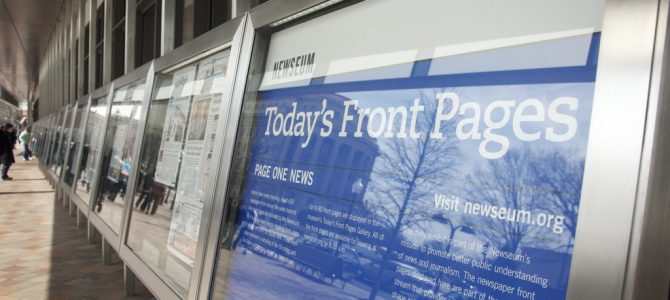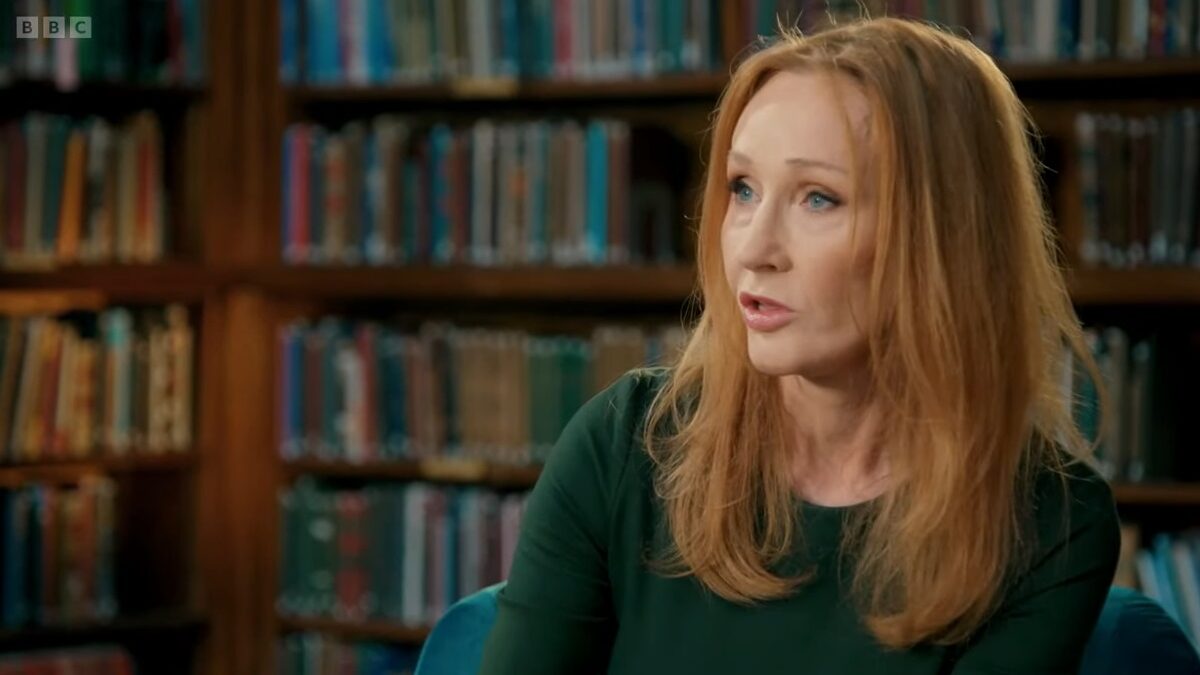
Newseum, “the museum of news,” is the flashiest museum in Washington DC. But very much like its neighbor down the street, the aircraft-hangar-esque East Wing of the National Gallery of Art, Newseum is an enormous temple to itself.
Its nearly half-billion-dollar building is an equal star to the generally absorbing exhibits inside. It’s glass, steel, and more glass, with a Wolfgang Puck restaurant in the back. The sixth-floor terrace provides a wide view of inauguration parades and the National Mall’s July 4 fireworks. Tourists strolling along the building’s Pennsylvania Avenue front linger to gaze at printouts of front pages of newspapers each day from each state, and a few from around the world. Hanging immediately above is a 50-ton, 74-feet-tall stone panel, chiseled into which is the text of the First Amendment.
So when the popular tourist destination together with its Newseum Institute presented winners of their Free Expression Awards at a sold-out dinner event April 18, it was worth wondering if its leaders had ever really bothered to look up. Since free expression at American universities has been stomped on so regularly, the real free expression warriors should be obvious. Instead, the group selected by Newseum is an odd collection.
I See Your Awardees and Raise You
The group honored includes: Rep. John Lewis; Apple CEO Tim Cook; Hugh and Kristy Hefner of Playboy; Martha Raddatz of ABC News; and Kristina Arriaga De Bucholz, of the Becket Fund for Religious Liberty, the religion rights advocacy firm.
Quibble with or cheer any of these individually. Becket Law is an effective organization. Lewis has morphed from true civil rights hero to official Democratic grandstander (or sitter, as the case may be). Cook speaks for gay rights from an industry where this is expected. And Raddatz is either the greatest or the worst election debate moderator of the season, and did or did not cry on the air when it became clear that Donald Trump won election. The Hefners are … the Hefners.
Instead, how about these: Charles Murray, Heather MacDonald, Christina Hoff Sommers, David Horowitz, Ben Shapiro, Laura Kipnis, and Ann Coulter, who continue to venture onto campuses to speak their minds even though they have been shouted down, violently threatened, and at times forced to flee for their safety while university administrators cowered and refused to pursue punishments of rampaging students, and campus police arrest no one.
Or how about K.C. Johnson and Stuart Taylor, authors of the recent book “Campus Rape Frenzy.” These two collaborated on “Until Proven Innocent,” the definitive work on the Duke men’s lacrosse team non-rape fiasco. The duo offer an equally meticulous and at times scalding indictment of what has become a grim trend at universities across the country, where the accused are denied free expression as they struggle to navigate campus kangaroo courts.
Early this month, Ayaan Hirsi Ali canceled her “Hero of Heresy” tour across Australia, citing lack of security as one reason. The courageous activist speaks out for women’s rights globally, particularly those in Muslim countries. Her life has been threatened as she continues to travel and challenge politically correct discourse in the West about Islam.
So Much for Speaking Truth to Power
Financially troubled for years, the museum and its associated organizations position themselves as nonpartisan. Newseum caved under pressure from pro-Palestinian voices a few years ago, reinstating to its journalist memorial database the names of two journalists killed by the Israeli Defense Forces. The Anti-Defamation League said the two were Hamas propagandists.
Newseum also took heat for allowing Al-Jazeera to use Newseum’s studio space for its nightly news show. Various exhibits over the years have conflated noteworthy journalism with left-wing causes and positions, including immigration.
Although Newseum and its parent organization Freedom Forum have changed some leadership in recent years, stubbornness is a constant. The Washington Post reported in 2015 that Wayne Reynolds, “a D.C. philanthropist who helped stabilize Ford’s Theatre,” ended up leaving Newseum’s board of trustees after only a few months. “They brought me on as an agent of change, but change is the last thing they’re interested in,” Reynolds told the Post.
Last week, Newseum released a curious white paper titled “Addressing the Real Crisis of Free Expression on Campus.” While framing the problem as generational, the paper, attributed to Jeffrey Herbst, Newseum’s president and CEO, scolded the media for focusing on “elite, highly selective colleges that are in many ways not representative of other campuses …”
The paper blames K-12 educators, then praises Newseum for hosting some student leaders in 2016 to discuss the issue. It references “hate speech” but does not define it, and strains to avoid the ideological forces in play. Too little, too late. All the while, harassment of students groups continues at universities in ways we don’t read about.
Newseum Shies from Endemic Speech Problems
Early in April, the Young Americans For Freedom student group at George Washington University pointed out that posters were torn down announcing their hosting of feminist scholar Christina Hoff Sommers. The group notes their posters have been torn down in the past, for speakers such as Shapiro and Bay Buchanan. Students file a report with campus police and other campus organizations, and have reached out to university administrators. But nothing happens.
This kind of thing brings barely a ripple of attention. In America, when debate is constant over just how free expression should be defined, leaders of institutions which claim to instruct the rest of us in its meaning and application could be sources of clarity and insight. The way they could do this is to acknowledge, in their awards, exhibits, and programming, the major speech problems in American society and the world. As George Orwell wrote, “to see what is in front of one’s nose needs a constant struggle.”
Or, when wandering down Pennsylvania Avenue, they could simply look up.









